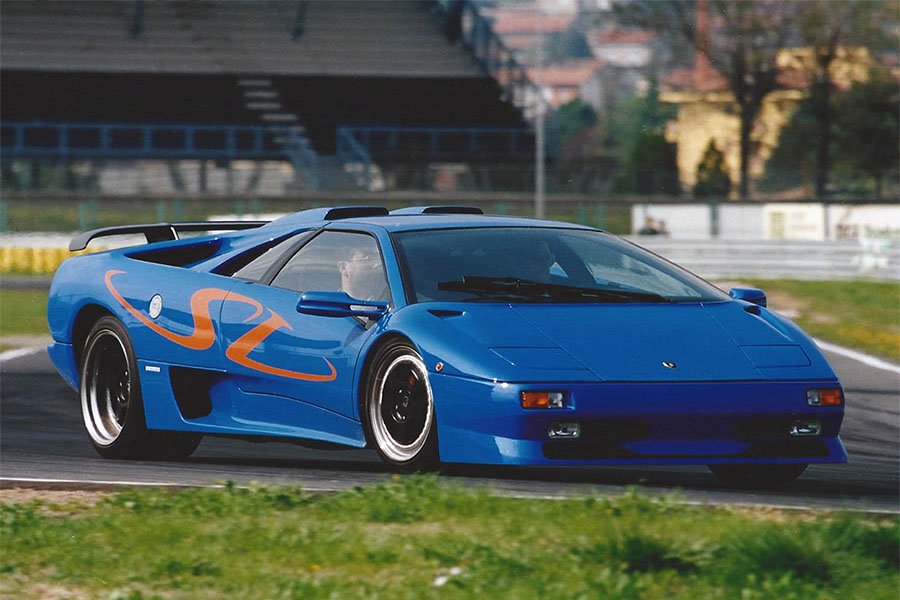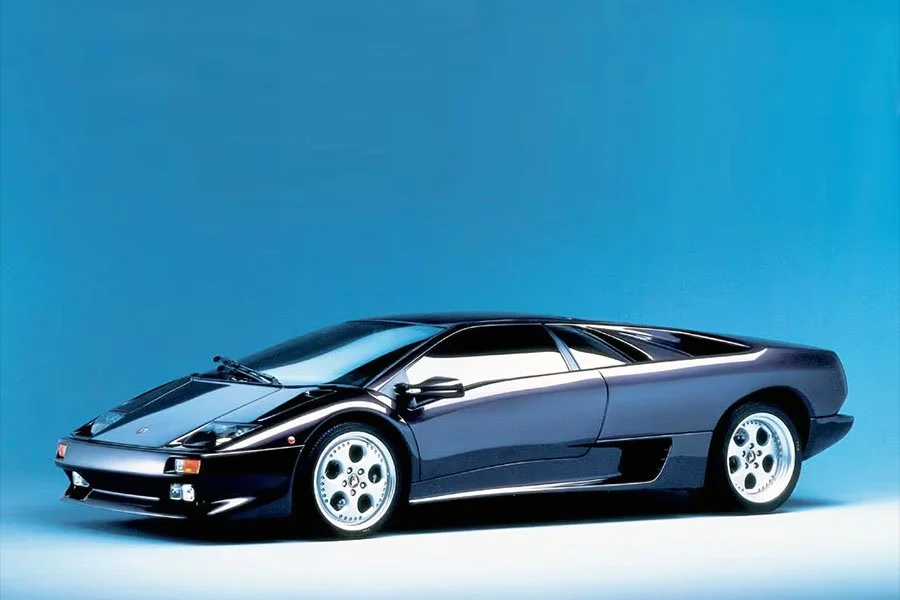Guide: Back-to-Basics - a Historical & Technical Appraisal of the Lamborghini Diablo SV
/BACKGROUND
When Chrysler acquired Automobili Lamborghini in 1987, the American firm hoped they would be able to sell several hundred examples of a highly anticipated Countach successor every year. Even more ambitiously, Chrysler expected to shift well over a thousand Jalpa replacements during the same timeframe.
Unfortunately, Chrysler’s sales targets were influenced by the boom days from late 1987 through to early 1990 which was not at all representative of normal market conditions; as a result of the late ‘87 stockmarket crash, high end exotic and collectable motor cars came to be perceived as an alternative high-yielding asset class. Buyers flocked to get their hands on the latest and greatest machinery at almost any price - deposits for new cars were being put down at an unprecedented pace by customers hoping to make a killing in the secondary market.
The result was that, at the height of the craziness in spring 1990, pre-owned cars were sometimes trading at multiples of their original list price.
When the market collapsed in mid 1990, buyers were hard to find. Lamborghini were left with a large stock of Diablos that took years to sell.
In November 1993, Chrysler bailed out and sold Lamborghini to Megatech, a Bermuda-registered holding company for Malaysian investment group, Mycom Setdco, and Indonesian group, V Power Corporation.
Back in March of ‘93, Lamborghini had released a four-wheel drive Diablo VT to complement the original rear-drive version. A few months later, a hardcore limited edition Diablo SE30 was announced to celebrate the firm’s 30th anniversary.
The 150 SE30 production cars were subsequently produced between June 1994 and November 1995 (once the order book had been filled).
However, by late ‘94, sales of the rear-drive Diablo and four-wheel drive Diablo VT had slowed to a trickle. With trading conditions still not great, to stimulate demand the company released an exciting new back-to-basics variant at the Geneva Motor Show in March 1995.
The resultant Diablo SV came with a more powerful engine and several SE30-inspired cosmetic updates. Just as importantly, SV was priced at 10% less than the standard rear-drive Diablo.
The SV moniker (which in this instance stood for Sport Veloce) was a nod to Lamborghini’s legendary Miura of the same name produced between 1971 and 1973.
The Diablo SV appealed to those customers who preferred the purebred nature of rear-wheel drive and for whom performance was everything. It ultimately proved a big hit and effectively killed off demand for the original rear-drive Diablo (despite not initially having been available for sale in the USA on emissions grounds).
CHASSIS
Like the SE30, the Diablo SV was based on the rear-wheel drive Diablo platform . This meant it did without four-wheel drive and electronic Koni dampers (as fitted to the VT).
The chassis comprised a square-tubed steel spaceframe reinforced around the cockpit with carbonfibre inserts and high strength alloys. The wheelbase measured 2670mm.
Suspension was via independent double wishbones with single coil sprung dampers at the front and two dampers per side at the back. Anti-roll bars were fitted at either end. The front axle also incorporated anti-dive electronics.
Ventilated brake discs and calipers were supplied by Brembo. 330mm diameter discs with four-piston calipers were installed at the front. The back end ran the larger 310mm discs (that had been introduced for 1994) with twin piston calipers.
At this stage, Diablos did not come with an Anti-lock Brake System but power steering was standard.
New split rim SV-branded OZ Racing wheels were unique to the Super Veloce. Like the SE30, they measured 17 x 8.5-inches at the front and 18 x 13-inches at the rear. Wheel centres could be finished in black, natural or body colour. The rims were originally shod with Pirelli P Zero tyres.
As usual, a single 100-litre fuel tank was located on the right-hand side of the engine bay up against the rear bulkhead.
ENGINE / TRANSMISSION
The SV engine was a mid-range offering between the standard 492bhp Diablo unit and the 525bhp motor fitted to the SE30.
Like the SE30, the SV came with re-programmed LIE digital multi-point fuel-injection and a free-flow sports exhaust (now with oval tail pipes). However, this newest variant did not receive the SE30’s expensive magnesium cylinder heads or intake manifolds.
The rest of the SV engine specification was much the same as every Diablo variant thus far. It incorporated an all-alloy construction with dual overhead camshafts, four valves per cylinder, dry-sump lubrication and three-way catalytic converters.
Displacement was 5709cc thanks to a bore and stroke of 87mm and 80mm respectively.
A 10.0:1 compression ratio was retained.
In this configuration, this latest iteration of Lamborghini’s Giotto Bizzarrini-designed 60° V12 produced 510bhp at 7100rpm and 428lb-ft at 5900rpm.
For comparison, the SE30 produced 525bhp at 7000rpm and 428lb-ft at 5200rpm.
The standard Diablo and VT pumped out 492bhp at 7000rpm and an identical peak torque rating as the SE30.
Transmission was via a five-speed gearbox with new ratios, a dry single-plate clutch, a ZF final drive and limited-slip differential.
BODYWORK
Thanks to a number of cosmetic enhancements, the SV was arguably the best-looking Diablo yet.
At the front, the bumper’s lower section featured single spot lamps per side outboard of new air intakes and a pair of additional base ducts (accessorised with satin black accents).
SE30-derived features included the Jota-style twin-scoop engine cover, exposed aluminium fuel filler cap, enlarged cooling grille between the tail lights, rear bumper (with integrated fog and reverse lights) and lightweight rear wing with adjustable Gurney flap. In standard trim, the SV’s rear spoiler was given a carbon black finish.
Down each flank, the intakes ahead of each rear wheelarch were bereft of any internal blades and enormous SV decals were fitted.
INTERIOR
The SV used the less obtrusive dash and instrument binnacle assembly introduced on the Diablo VT.
In standard trim, leather was replaced with suede alcantara; this sporty high-grip anti-glare material was used to upholster the dash, instrument binnacle, centre console, seats, rear bulkhead and the simplified door panels. Sound-proofing was also reduced and a carbon-topped Momo shift knob was installed.
Like the SE30, white-faced dials replaced the black-faced gauges normally seen in the Diablo. Large analogue read outs for road and engine speed were flanked by smaller gauges for oil pressure, oil temperature, water temperature and fuel.
Electric windows, electric mirrors, air-conditioning and a high-end audio system were standard along with a three-spoke, non-airbag steering wheel.
OPTIONS
At no cost, customers could have the enormous SV decals supplied but not fitted. There was also the option to have the rear spoiler painted body colour or deleted.
For the cockpit, Lamborghini offered a full leather leather or leather-alcantara upholstery, a bi-colour interior, contrast seat piping and stitching, coloured instrument faces, four-point harnesses, an audio system and the SV logo embroidered into the headrests.
Other optional extras included a sports exhaust, SVR front lip spoiler, close-ratio gearbox, SE30 wheels, SE30 side intake blades, SE30 carbonfibre door panels, carbonfibre inserts for the instrument fascia and centre console, carbonfibre engine bay panels and a set of leather luggage.
WEIGHT / PERFORMANCE
Weight was officially unchanged from the regular rear-drive Diablo at 1576kg.
Top speed went from 202mph to 204mph.
The SV was also a tenth-of-a-second quicker to 62mph (3.8 seconds compared to 3.9).
1998 MODEL YEAR
For the 1998 model year (production of which started in October 1997), Lamborghini introduced an uprated SV.
The key difference was a new variable valve timing system that enabled the engine to use different camshaft profiles at low and high revs to reduce emissions and increase power respectively.
Peak output went up to 530bhp at 7100rpm and 446lb-ft at 5500rpm (compared to 510bhp at 7100rpm and 428lb-ft at 5900rpm for the outgoing model).
Importantly, the addition of variable valve timing enabled Lamborghini to sell the SV in the USA. Those cars destined for the US came with heavier but visually identical bumpers, rectangular side marker lights and were normally kitted out with a full leather interior.
Other upgrades included installation of the latest generation Lucas ABS software, 18-inch diameter front wheels (up from 17), larger cross-drilled and vented 355mm front and 335mm rear brake discs (up from 330mm and 310mm respectively), four-piston brake calipers all round and a four-spoke airbag steering wheel.
New options included a front axle lifter and the four-way electronically-adjustable Koni dampers from the VT.
The ‘98 model year Diablo SV was publicly unveiled at the Detroit Motor Show in January 1998.
SV ROADSTER
At the Geneva Motor Show in March 1998, Lamborghini introduced an SV Roadster.
As per the VT Roadster, the open SV variant came with a carbonfibre targa top that, once removed, stowed over the engine. Similarly, the rear deck was configured with new sail panel treatment and reworked cooling ducts.
Unlike the roof-less VT, the SV Roadster used the same front bumper as the fixed-head variant.
SE30-style vertical intake blades were added to the intakes located ahead of the rear wheels.
Weight and 0-62mph times were officially unchanged (1576kg and 3.8 seconds) but the top speed was 5mph slower (199mph).
MONTEREY EDITION
Another new SV variant launched in 1998 was the Monterey Edition: a batch of 20 fixed-head cars destined for the US market.
Each was equipped with SE30 cooling vent blades ahead of the rear wheels, chrome-plated wheels, a body coloured spoiler, leather upholstery and a set of SV Monterey Edition-branded fitted luggage.
VAG BUYS AUTOMOBILI LAMBORGHINI
In July 1998, Megatech sold Automobili Lamborghini to the Volkswagen Audi Group. The deal was instigated by VAG chairman, Ferdinand Piech, who also concluded deals to buy Bugatti and Bentley the same year.
END OF PRODUCTION
Three months after the acquisition by VAG, Lamborghini launched an updated Diablo SV at the Paris Motor Show (in October 1998).
The new 1999 model year Diablos (covered separately) were actually the culmination of two years intensive work. They came with further uprated brakes, improved safety gear, a redesigned interior and distinctive glass headlight covers.
By the time production of the pre-99 model year SV ended, 196 cars are understood to have been completed. Of these, circa 40 were right-hand drive. The overall figure included just six SV Roadsters, all of which were left-hand drive.
Text copyright: Supercar Nostalgia
Photo copyright: Lamborghini - https://www.lamborghini.com









































